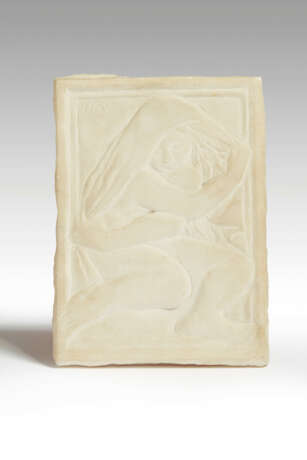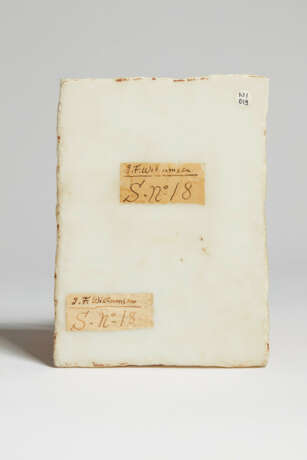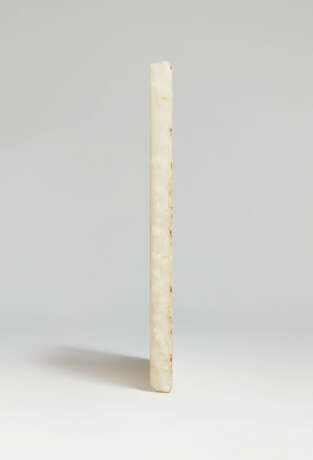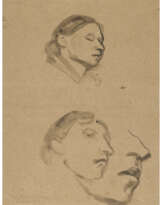ID 1051755
Lot 421 | Jens Ferdinand Willumsen (1863-1958)
Estimate value
€ 2 800 – 3 500
Baigneuse
signé des initiales ‘J.F.W’ (en haut à gauche); signé et numéroté deux fois ‘J.F. Willumsen S-no.-18’ (sur deux étiquettes au revers)
bas-relief en marbre
23 x 17.2 cm.
Conçu et exécuté vers 1920; cette œuvre est unique
signed with the initials 'J.F.W' (upper left); signed and numered twice 'J.F. Willumsen S-no.-18’ (on two labels on the reverse)
marble bas-relief
9 x 6 ¾ in.
Conceived and executed circa 1920; this work is unique
Provenance
Atelier de l'artiste.
Michelle Bourret, France (par succession).
Maurice Malingue, Paris (acquis auprès de celle-ci en 1960).
Sam Josefowitz, Pully (acquis auprès de celui-ci le 14 décembre 1980).
Puis par descendance aux propriétaires actuels.
Further details
Jens Ferdinand Willumsen, né à Copenhague en 1863, est un pionnier de l’art pictural moderne danois. Après avoir suivi étudié notamment à l'Académie royale des Beaux-Arts de Copenhague, Willumsen effectue plusieurs séjours à Paris. Rapidement, l’artiste s’intéresse aux préceptes de l’École de Pont-Aven grâce à son amitié avec Paul Gauguin et Paul Sérusier qu’il rencontre à Pont-Aven dès 1890. Il s'installe en effet, dès le mois de juillet de cette même année à la Pension Gloanec. Déjà familier du travail de Paul Gauguin, qu'il avait pu voir à Copenhague ou chez Théo Van Gogh à Paris, l'artiste se lie rapidement avec Gauguin, lui rendant visite notamment au Pouldu.
Son style restera longtemps marqué par l’influence du cloisonnisme, du synthétisme et des nabis, avant de revenir vers un style plus expressionniste à partir des années 1910. Ses œuvres furent montrées au Salon, au Salon de la Société nationale des Beaux-Arts, au Salon des Artistes Indépendants, chez Le Barc de Boutteville ainsi qu'à l'Exposition universelle de 1900. Après un séjour à Copenhague, de 1897 à 1900, puis de nombreux déplacements aux États-Unis, en Italie, en Suisse, en Norvège, en Espagne, en Afrique du Nord, il se fixe en 1916 dans le Sud de la France (Villefranche, Nice, Cannes, Le Cannet) où il y restera jusqu'à la fin de sa vie. Willumsen retournera épisodiquement au Danemark mais continuera cependant d'y exposer régulièrement. En dehors de la peinture, le danois s’intéressa à la sculpture, à l'architecture, à la céramique et pratiqua la gravure et la photographie. Son œuvre reste cependant rarissime dans les collections publiques françaises.
Born in Copenhagen in 1863, Jens Ferdinand Willumsen was a pioneer of modern Danish art. After studying at the Royal Academy of Fine Arts in Copenhagen, Willumsen made several trips to Paris. He quickly became interested in the precepts of the Pont-Aven School, fueled by his friendship with Paul Gauguin and Paul Sérusier, whom he met in Pont-Aven in 1890. That same year, in July, he moved into the Pension Gloanec. He was familiar with Paul Gauguin's work, that he had seen in Copenhagen and at Théo Van Gogh's house in Paris. Willumsen quickly became friends with Gauguin, regularly visiting him at Le Pouldu. For a long time, his style was impregnated by the influence of Cloisonnism, Synthesism and the Nabis, before he returned to a more expressionist style after the 1910s. His works were shown at the Salon, the Salon de la Société nationale des Beaux-Arts, the Salon des Artistes Indépendants, at Le Barc de Boutteville and at the 1900 Universal Exhibition. After returning to Copenhagen from 1897 to 1900, he travelled to the United States, Italy, Switzerland, Norway, Spain and North Africa, before settling in the South of France (Villefranche, Nice, Cannes, Le Cannet) in 1916 where he remained until the end of his life. Willumsen returned to Denmark from time to time, and continued to exhibit there regularly. As well as painting, the Dane was interested in sculpture, architecture, ceramics, engraving and photography. However, his work remains extremely rare in French public collections.
| Artist: | Jens Ferdinand Willumsen (1863 - 1958) |
|---|---|
| Medium: | Stone |
| Artist: | Jens Ferdinand Willumsen (1863 - 1958) |
|---|---|
| Medium: | Stone |
| Address of auction |
CHRISTIE'S 9 Avenue Matignon 75008 Paris France | ||||||||||||||
|---|---|---|---|---|---|---|---|---|---|---|---|---|---|---|---|
| Preview |
| ||||||||||||||
| Phone | +33 (0)1 40 76 85 85 | ||||||||||||||
| Fax | +33 (0)1 40 76 85 86 | ||||||||||||||
| Conditions of purchase | Conditions of purchase | ||||||||||||||
| Shipping |
Postal service Courier service pickup by yourself | ||||||||||||||
| Payment methods |
Wire Transfer | ||||||||||||||
| Business hours | Business hours
|







